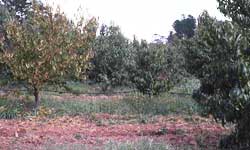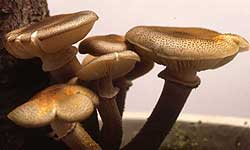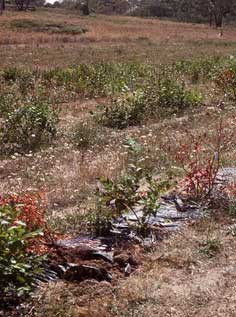Armillaria root rot
Armillaria root rot, also known as the honey toadstool or bootlace fungus, is a widespread and often destructive disease that can affect an extremely wide range of plants.
Overseas, the disease is reported to be caused by Armillaria mellea. But in Australia a related indigenous fungus Armillaria luteobubalina is the most common cause of Armillaria root rot.
Symptoms of Armillaria root rot
Above-ground symptoms on infected plants are:
- leaf yellowing (Figure 1)
- stunting
- limb dieback
- tree death (Figure 2).


The most distinctive symptoms, found only on closer examination of affected trees, are:
- rotted roots and stems
- creamy-white felt-like areas of fungal mycelium immediately below the bark of infected wood (Figure 3)
- dark bootlace-like fungal strands (rhizomorphs), which can sometimes be found growing through the soil and attached to the host roots (Figure 4).
Occasionally, after an infected tree has died, honey-coloured clusters of toadstools grow from the base of the tree (Figure 2). These usually appear from May to July. The toadstools (the fruiting bodies of the fungus) have honey-coloured to deep brown caps covered with scales, whitish gills and yellow to brown stems with a pronounced ring or collar around the upper part of the stem (Figure 5).


Host range and economic importance
Armillaria root rot affects:
- all fruit trees
- most native trees
- ornamentals, including rhododendrons and azaleas
- some herbaceous crops such as potatoes, rhubarb and strawberries.
Orchards
When compared with other more common orchard diseases, Armillaria root rot is only of minor importance. In an affected orchard this disease can be destructive, and effective control is very difficult.

Native environments
A. luteobubalina is a widespread and endemic pathogen of native forests. It generally kills trees weakened by:
- competition
- age
- disturbance, or
- environmental stress, such as fire and drought.
In healthy, undisturbed environments it's generally not a problem.
Because Armillaria can live saprophytically on dead stumps, it's often a problem in newly cleared areas where crops or gardens are planted. But grasses (Gramineae) and some herbaceous ornamental and vegetable plants can be successfully planted on infected sites.
Disease cycle
The fungus can spread in several ways, but usually spread is from a woody food base such as an infected tree or stump, or a small piece of infected root.
Most spread is by root contact: the fungus grows from a diseased root into a healthy root via the point of contact of the roots. Rhizomorphs can grow from infected roots through the soil to roots of a nearby plant.
Airborne spores produced by the toadstools can be another method of spread, although these spores can only infect dead or injured wood.
Cultivation may also spread the fungus by moving diseased root pieces from infested sites into adjoining healthy areas.
The main sources of infection in orchards are:
- infected, dying trees within the orchard
- dead stumps or root pieces persisting in the ground from an earlier planting that was infected with the disease, or
- the original vegetation (trees in native forests are often infected with Armillaria).
The disease often spreads radially from one tree to surrounding trees, and replants within the affected area usually die within a few years unless the site is treated (Figure 6).

Controlling Armillaria root rot
Control of Armillaria root rot is difficult. Methods that have been tested include:
- removal of infected trees and roots to reduce inoculum
- trenching around affected trees
- creating root barriers to prevent spread of the pathogen
- exposure of the collar of infected trees
- reducing the food source available to the pathogen by physical removal of root pieces, or by inoculation of stumps with other wood-rotting organisms
- biological control using Trichoderma or other antagonistic fungi
- chemical control using fumigants, fungicides and other materials.
The following recommendations give a practical approach to Armillaria control in orchard situations.
When clearing and planting new ground
- Ring-bark native trees and leave for at least 6 months before removing them, so that starch reserves in the tree are depleted. This lowers the chance of such trees becoming centres of infection.
- Rip the area thoroughly, and remove and burn all stumps and large roots.
- Leave the area under pasture for at least 2 to 3 years to allow small roots to rot.
When treating slightly affected trees
- Remove soil from around the butt and main roots to a radius of about 750mm. A high-pressure jet of water from a spray pump is a convenient way to remove soil from around affected trees.
- Cut out and burn diseased bark and roots, and paint cuts with a plastic paint. Leave the crown and roots permanently uncovered and do not replace soil during cultivation. This will halt the development of the disease, as exposure to air kills Armillaria.
- Remove and burn all badly affected trees, including roots.
Treatment before replanting severely affected sites
Armillaria can be controlled by soil fumigation, but control depends on the complete eradication of the fungus. To achieve this, the extent of infestation must be determined accurately and the entire infested area must be fumigated after suitable preparation of the soil.
- Map the affected area to find the extent of the infection within the orchard. Include all trees showing poor growth, all replants within the affected area plus 2 rows of apparently healthy trees adjacent to the affected area.
- Check trees for infection by exposing the roots and butts. To do this, remove soil from around the butt and main roots to a radius of about 750mm. A high-pressure jet of water from a spray pump might help. You can also check the trees by removing a small piece of bark from this region. On infected trees this will reveal a creamy-white mycelial fan. If rhizomorphs or mycelial fans are found on any apparently healthy trees, then adjacent trees should also be checked as well.
- Remove all the affected trees within the area, and as many roots as possible, and burn on the spot. Do not move this material from the site, or cultivate outwards from the affected area, as the disease spreads readily through infected roots and stems.
- Plant a cover crop to lower soil moisture during spring and summer before fumigation. The soil should have dried to a depth of 600mm to 700mm. This is important as the fumigant must contact deeply buried infected root pieces that could cause re-infection.
- Deep rip to at least 600mm, then disc to a fine tilth.
- In late summer, while soil moisture is still very low, fumigate the affected area to a depth of 400mm. Seal with polythene sheet for at least 24 hours. Do not fumigate soil that is closer than 2m from surrounding healthy trees because this could kill them.
- Replant only when it is safe to do so – usually about 1 month after treatment.
Reporting an unusual plant insect pest or disease
Report any unusual plant pest or disease immediately using our online reporting form or by calling the Exotic Plant Pest Hotline on 1800 084 881. Early reporting increases the chance of effective control and eradication.
Please take multiple good quality photos of the pests or damage to include in your report where possible, as this is essential for rapid pest and disease diagnosis and response.
Your report will be responded to by an experienced staff member, who may seek more information about the detection and explain next steps.
Report onlinePhoto credits
Figures 2 and 3 courtesy of Robinson, R. 2008
Reference
Robinson, R. 2008 Recognising Armillaria root disease. Science Division Department of Environment and Conservation Manjimup, WA, 12pp. 6258